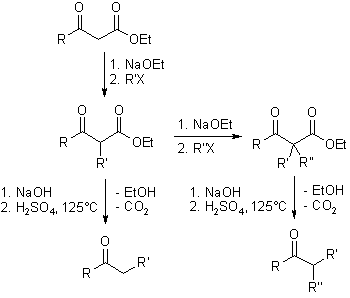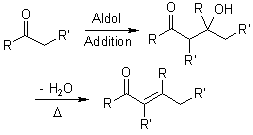Acetoacetic Ester Synthesis

When α-keto acetic acid is treated with one mole of a base, the methylene group which is more acidic reacts with the base. And the reaction with an alkylation reagent gives alkyl products attached to methylene. When this reaction is repeated in the next step, the other hydrogen can also react to a dialkyl product. The two alkylation agents may be the same or different (R',R'').
β-Keto esters tend to decarboxylate after hydrolysation to β-keto carboxylic acid and heating to give one or two alkyl-substituted ketones, respectively.

If two moles of a base are added in the first step, the hydrogen of the more acidic methylene group, and in the next step the hydrogen of the methyl group (ambident nucleophiles), reacts with the base. The hydrogenated methyl group is, however, more acidic than the hydrogenated methylene group. The reaction with alkylation agent in the following step gives a product substituted at methyl group. This can be synthetically used to prepare selectively ketones of different types.
Acyloin Condensation

The bimolecular reductive coupling of carboxylic esters by reaction with metallic sodium in an inert solvent under reflux gives an α-hydroxyketone, which is known as an acyloin. This reaction is favoured when R is an alkyl. With longer alkyl chains, higher boiling solvents can be used. The intramolecular version of this reaction has been used extensively to close rings of different sizes, e.g. paracyclophanes or catenanes.

If the reaction is carried out in the presence of a proton donor, such as alcohol, simple reduction of the ester to the alcohol takes place (Bouveault-Blanc Reduction).
The Benzoin Condensation produces similar products, although with aromatic substituents and under different conditions.
When the acyloin condensation is carried out in the presence of chlorotrimethylsilane, the enediolate intermediate is trapped as the bis-silyl derivative. This can be isolated and subsequently is hydrolysed under acidic condition to the acyloin, which gives a better overall yield.
Mechanism of Acyloin Condensation




Aldol Condensation

In some cases, the adducts obtained from the Aldol Addition can easily be converted (in situ) to α,β-unsaturated carbonyl compounds, either thermally or under acidic or basic catalysis. The formation of the conjugated system is the driving force for this spontaneous dehydration. Under a variety of protocols, the condensation product can be obtained directly without isolation of the aldol.
The aldol condensation is the second step of the Robinson Annulation.
Mechanism of the Aldol Condensation
For the addition step see Aldol Addition

Arndt-Eistert Synthesis

The Arndt-Eistert Synthesis allows the formation of homologated carboxylic acids or their derivatives by reaction of the activated carboxylic acids with diazomethane and subsequent Wolff-Rearrangement of the intermediate diazoketones in the presence of nucleophiles such as water, alcohols, or amines.
Mechanism of the Arndt-Eistert Synthesis
In the first step of this one-carbon homologation, the diazomethane carbon is acylated by an acid chloride or mixed anhydride, to give an α-diazoketone. The excess diazomethane can be destroyed by addition of small amounts of acetic acid or vigorous stirring. Most α-diazoketones are stable and can be isolated and purified by column chromatography (see recent literature for specific methods).
The key step of the Arndt-Eistert Homologation is the Wolff-Rearrangement of the diazoketones to ketenes, which can be accomplished thermally (over the range between r.t. and 750°C [Zeller, Angew. Chem. Int. Ed., 1975, 14, 32.]), photochemically or by silver(I) catalysis. The reaction is conducted in the presence of nucleophiles such as water (to yield carboxylic acids), alcohols (to give alcohols) or amines (to give amides), to capture the ketene intermediate and avoid the competing formation of diketenes.

The method is widely used nowadays for the synthesis of β-amino acids. Peptides that contain β-amino acids feature a lower rate of metabolic degradation and are therefore of interest for pharmaceutical applications.
Azo Coupling

Azo coupling is the most widely used industrial reaction in the production of dyes, lakes and pigments. Aromatic diazonium ions acts as electrophiles in coupling reactions with activated aromatics such as anilines or phenols. The substitution normally occurs at the para position, except when this position is already occupied, in which case ortho position is favoured. The pH of solution is quite important; it must be mildly acidic or neutral, since no reaction takes place if the pH is too low.
Mechanism of Azo Coupling


Baeyer-Villiger Oxidation

The Baeyer-Villiger Oxidation is the oxidative cleavage of a carbon-carbon bond adjacent to a carbonyl, which converts ketones to esters and cyclic ketones to lactones. The Baeyer-Villiger can be carried out with peracids, such as MCBPA, or with hydrogen peroxide and a Lewis acid.
The regiospecificity of the reaction depends on the relative migratory ability of the substituents attached to the carbonyl. Substituents which are able to stabilize a positive charge migrate more readily, so that the order of preference is: tert. alkyl > cyclohexyl > sec. alkyl > phenyl > prim. alkyl > CH3. In some cases, stereoelectronic or ring strain factors also affect the regiochemical outcome.
The reaction of aldehydes preferably gives formates, but sometimes only the liberated alcohol may be isolated due to the solvolytic instability of the product formate under the reaction conditions.
Mechanism of the Baeyer-Villiger Oxidation



Baker-Venkataraman Rearrangement

The base-induced transfer of the ester acyl group in an o-acylated phenol ester, which leads to a 1,3-diketone. This reaction is related to the Claisen Condensation, and proceeds through the formation of an enolate, followed by intramolecular acyl transfer.
Mechanism of the Baker-Venkataraman Rearrangement


Balz-Schiemann Reaction

The conversion of aryl amines to aryl fluorides via diazotisation and subsequent thermal decomposition of the derived tetrafluoroborates or hexafluorophosphates. The decomposition may also be induced photochemically.
Mechanism of the Balz-Schiemann Reaction
see Diazotisation.The mechanism of the Balz-Schiemann reaction remains obscure. A possible pathway is shown below:

Beckmann Rearrangement

An acid-induced rearrangement of oximes to give amides.
This reaction is related to the Hofmann and Schmidt Reactions and the Curtius Rearrangement, in that an electropositive nitrogen is formed that initiates an alkyl migration.
Mechanism of the Beckmann Rearrangement

Oximes generally have a high barrier to inversion, and accordingly this reaction is envisioned to proceed by protonation of the oxime hydroxyl, followed by migration of the alkyl substituent "trans" to nitrogen. The N-O bond is simultaneously cleaved with the expulsion of water, so that formation of a free nitrene is avoided.


Benzilic Acid Rearrangement

1,2-Diketones undergo a rearrangement in the presence of strong base to yield α-hydroxycarboxylic acids. The best yields are obtained when the subject diketones do not have enolizable protons.
The reaction of a cyclic diketone leads to an interesting ring contraction:

Ketoaldehydes do not react in the same manner, where a hydride shift is preferred (see Cannizzaro Reaction)
Mechanism of Benzilic Acid Rearrangement

Benzoin Condensation

The Benzoin Condensation is a coupling reaction between two aldehydes that allows the preparation of α-hydroxyketones. The first methods were only suitable for the conversion of aromatic aldehydes.
Mechanism of Benzoin Condensation
Addition of the cyanide ion to create a cyanohydrin effects an umpolung of the normal carbonyl charge affinity, and the electrophilic aldehyde carbon becomes nucleophilic after deprotonation: A thiazolium salt may also be used as the catalyst in this reaction (see Stetter Reaction).
A strong base is now able to deprotonate at the former carbonyl C-atom:

A second equivalent of aldehyde reacts with this carbanion; elimination of the catalyst regenerates the carbonyl compound at the end of the reaction:


Birch Reduction

The Birch Reduction offers access to substituted 1,4-cyclohexadienes.
Mechanism of the Birch Reduction

The question of why the 1,3-diene is not formed, even though it would be more stable through conjugation, can be rationalized with a simple mnemonic. When viewed in valence bond terms, electron-electron repulsions in the radical anion will preferentially have the nonbonding electrons separated as much as possible, in a 1,4-relationship.
This question can also be answered by considering the mesomeric structures of the dienyl carbanion:

The numbers, which stand for the number of bonds, can be averaged and compared with the 1,3- and the 1,4-diene. The structure on the left is the average of all mesomers depicted above followed by 1,3 and 1,4-diene:

The difference between the dienyl carbanion and 1,3-diene in absolute numbers is 2, and between the dienyl carbanion and 1,4-diene is 4/3. The comparison with the least change in electron distribution will be preferred.
Reactions of arenes with +I- and +M-substituents lead to the products with the most highly substituted double bonds:

The effect of electron-withdrawing substituents on the Birch Reduction varies. For example, the reaction of benzoic acid leads to 2,5-cyclohexadienecarboxylic acid, which can be rationalized on the basis of the carboxylic acid stabilizing an adjacent anion:

Alkene double bonds are only reduced if they are conjugated with the arene, and occasionally isolated terminal alkenes will be reduced.

Bischler-Napieralski Reaction
Bischler-Napieralski Cyclization
The Bischler-Napieralski Reaction allows the synthesis of 3,4-dihydroisoquinolines from the β-ethylamides of electron-rich arenes using condensation reagents such as P2O5, POCl3 or ZnCl2.
Mechanism of the Bischler-Napieralski Reaction
According to detailed studies by Fodor and Nagubandi (Tetrahedron 1980, 36, 1279. ), the Bischler-Napieralski Reaction involves an initial dehydration step of the amide followed by a cyclization. Fodor was able to prepare stable imidoyl salts at room temperature that formed nitrilium salts upon mild heating, whereas the Bischler-Napieralski Reaction required elevated temperatures to form isoquinolines. A mechanism that includes nitrilium salts also accounts the occurrence of styrenes as side products as will be explained later.In the dehydration, reagents such as PCl5, POCl3, SOCl2, ZnCl2 can be used to promote loss of the carbonyl oxygen. Use of POCl3 leads first to formation of imidoyl phosphates in which phosphate is a good leaving group. Use of P2O5 or addition of P2O5 to a reaction with POCl3 leads to pyrophosphates, which are even better leaving groups.
For the cyclization, an activated arene is needed to effect ring closure at reflux temperature if the solvent is toluene. Alternatively, xylene can be used, and microwave-assisted chemistry in superheated solvents is also a viable solution.
One of the most important side reactions is the retro-Ritter reaction forming styrenes, which is also evidence for nitrilium salts as intermediates:
In this example, the formation of a conjugated system favors the retro-Ritter reaction. A possible solution is the use of the corresponding nitrile as solvent, which shifts the equilibrium to the left side, but some nitriles (R' ≠ Me) can be expensive. Another solution was recently presented by Larsen using oxalyl chloride to form an N-acyliminium intermediate, so that elimination of the amide group as the nitrile is avoided.

R. D. Larsen, R. A. Reamer, E. G. Corley, P. Davis, E. J. J. Grabowski, P. J. Reider, I. Shinkai, J. Org. Chem., 1991, 56, 6034-6038.
In the following recently published procedure by Movassaghi, Tf2O is used in the presence of 2-ClPyr to provide a mild cyclodehydration reaction. Here the authors suggest that electrophilic activation of N-alkylamides may lead to a transient highly electrophilic nitrilium ion (or pyridinium adduct) that is trapped by the arene ring.

M. Movassaghi, M. D. Hill, Org. Lett., 2008, 10, 3485-3488.
The two-step procedure reported by Larsen and the method described by Movassaghi allow the transformation of a broad range of substrates into 3,4-dihydroisoquinolines and the use of milder conditions. Some more procedures can be found in the Recent Literature section.
Brown Hydroboration

The syn-addition of hydroboranes to alkenes occurs with predictable selectivity, wherein the boron adds preferentially to the least hindered carbon. This selectivity is enhanced if sterically demanding boranes are used.

Coupling the hydroboration with a subsequent oxidation of the new formed borane yields anti-Markovnikov alcohols. The hydroboration/oxidation sequence constitutes a powerful method for the regio- and stereoselective synthesis of alcohols.
The product boranes may also be used as starting materials for other reactions, such as Suzuki Couplings (see Recent Literature).
Mechanism of the Brown Hydroboration
The selectivity of the first addition of borane can be relatively low:

The subsequent additions are more selective as the steric bulk increases, and anti-Markovnikov selectivity predominates in the end:

Oxidation with hydrogen peroxide leads to alcohols:

Sterically demanding boranes offer enhanced selectivity. One example of a sterically demanding borane (9-BBN) is generated by the double addition of borane to 1,5-cyclooctadiene:
 9-Borabicyclo[3.3.1]nonane
9-Borabicyclo[3.3.1]nonane

The reactivity and selectivity of the borane reagent may be modified through the use of borane-Lewis base complexes.
Cannizzaro Reaction

This redox disproportionation of non-enolizable aldehydes to carboxylic acids and alcohols is conducted in concentrated base.
α-Keto aldehydes give the product of an intramolecular disproportionation in excellent yields.

Mechanism of the Cannizzaro Reaction

An interesting variant, the Crossed Cannizzaro Reaction, uses formaldehyde as reducing agent:

At the present time, various oxidizing and reducing agents can be used to carry out such conversions (with higher yields), so that today the Cannizzaro Reaction has limited synthetic utility except for the abovementioned conversion of α-keto aldehydes.
The Cannizzaro Reaction should be kept in mind as a source of potential side products when aldehydes are treated under basic conditions.
Acetoacetic-Ester Condensation
:-Claisen Condensation

The Claisen Condensation between esters containing α-hydrogens, promoted by a base such as sodium ethoxide, affords β-ketoesters. The driving force is the formation of the stabilized anion of the β-keto ester. If two different esters are used, an essentially statistical mixture of all four products is generally obtained, and the preparation does not have high synthetic utility.
However, if one of the ester partners has enolizable α-hydrogens and the other does not (e.g., aromatic esters or carbonates), the mixed reaction (or crossed Claisen) can be synthetically useful. If ketones or nitriles are used as the donor in this condensation reaction, a β-diketone or a β-ketonitrile is obtained, respectively.
The use of stronger bases, e.g. sodium amide or sodium hydride instead of sodium ethoxide, often increases the yield.
The intramolecular version is known as Dieckmann Condensation.
Mechanism of the Claisen Condensation



Claisen Rearrangement

The aliphatic Claisen Rearrangement is a [3,3]-sigmatropic rearrangement in which an allyl vinyl ether is converted thermally to an unsaturated carbonyl compound.
The aromatic Claisen Rearrangement is accompanied by a rearomatization:

The etherification of alcohols or phenols and their subsequent Claisen Rearrangement under thermal conditions makes possible an extension of the carbon chain of the molecule.
Mechanism of the Claisen Rearrangement
The Claisen Rearrangement may be viewed as the oxa-variant of the Cope Rearrangement: Mechanism of the Cope Rearrangement
Mechanism of the Cope Rearrangement Mechanism of the Claisen Rearrangement
Mechanism of the Claisen RearrangementThe reaction proceeds preferably via a chair transition state. Chiral, enantiomerically enriched starting materials give products of high optical purity.

A boat transition state is also possible, and can lead to side products:

The aromatic Claisen Rearrangement is followed by a rearomatization:

When the ortho-position is substituted, rearomatization cannot take place. The allyl group must first undergo a Cope Rearrangement to the para-position before tautomerization is possible.

All Claisen Rearrangement reactions described to date require temperatures of > 100 °C if uncatalyzed. The observation that electron withdrawing groups at C-1 of the vinyl moiety exert a positive influence on the reaction rate and the yield has led to the development of the following variations:
 Ireland-Claisen Rearrangement
Ireland-Claisen Rearrangement Eschenmoser-Claisen Rearrangement
Eschenmoser-Claisen Rearrangement Johnson-Claisen Rearrangement
Johnson-Claisen RearrangementClemmensen Reduction

The Clemmensen Reduction allows the deoxygenation of aldehydes or ketones, to produce the corresponding hydrocarbon.
The substrate must be stable to strong acid. The Clemmensen Reduction is complementary to the Wolff-Kishner Reduction, which is run under strongly basic conditions. Acid-labile molecules should be reduced by the Wolff-Kishner protocol.
Mechanism of the Clemmensen Reduction
The reduction takes place at the surface of the zinc catalyst. In this reaction, alcohols are not postulated as intermediates, because subjection of the corresponding alcohols to these same reaction conditions does not lead to alkanes. The following proposal employs the intermediacy of zinc carbenoids to rationalize the mechanism of the Clemmensen Reduction:
Cope Elimination

N-Oxides give alkenes via a syn-elimination under heating. This reaction obeys Hofmann's Rule.
Mechanism of the Cope Elimination




